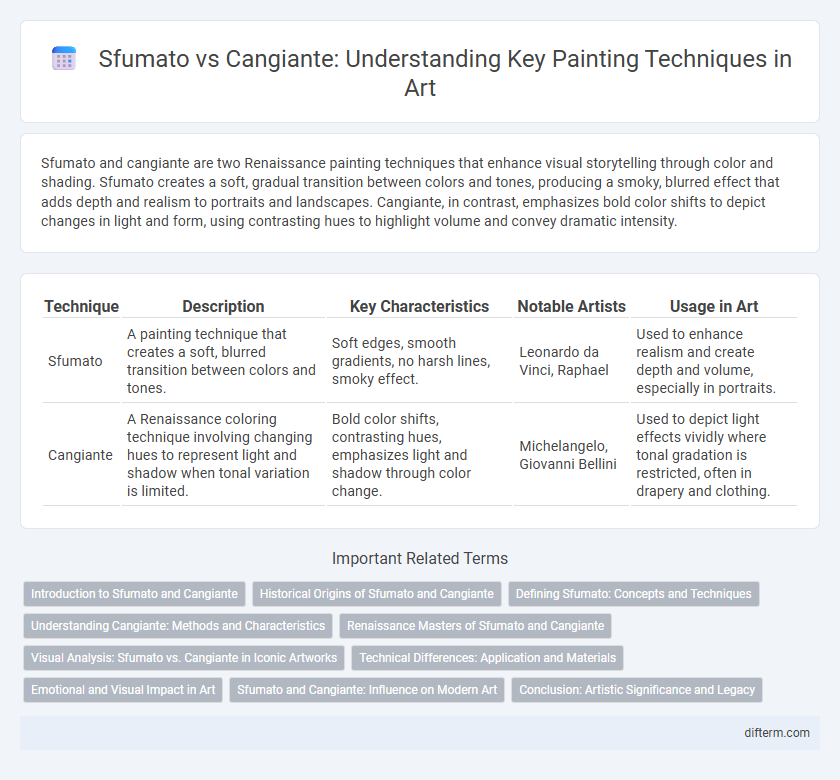Sfumato and cangiante are two Renaissance painting techniques that enhance visual storytelling through color and shading. Sfumato creates a soft, gradual transition between colors and tones, producing a smoky, blurred effect that adds depth and realism to portraits and landscapes. Cangiante, in contrast, emphasizes bold color shifts to depict changes in light and form, using contrasting hues to highlight volume and convey dramatic intensity.
Table of Comparison
| Technique | Description | Key Characteristics | Notable Artists | Usage in Art |
|---|---|---|---|---|
| Sfumato | A painting technique that creates a soft, blurred transition between colors and tones. | Soft edges, smooth gradients, no harsh lines, smoky effect. | Leonardo da Vinci, Raphael | Used to enhance realism and create depth and volume, especially in portraits. |
| Cangiante | A Renaissance coloring technique involving changing hues to represent light and shadow when tonal variation is limited. | Bold color shifts, contrasting hues, emphasizes light and shadow through color change. | Michelangelo, Giovanni Bellini | Used to depict light effects vividly where tonal gradation is restricted, often in drapery and clothing. |
Introduction to Sfumato and Cangiante
Sfumato, popularized by Leonardo da Vinci, is a painting technique characterized by subtle gradations of tone that create a smoky, blurred effect, enhancing realism through soft transitions between colors and shadows. Cangiante, used extensively during the Renaissance, involves shifting to a different hue to depict light and shadow when tonal variation within a single color is limited, creating vibrant contrasts and dynamic color changes. Both techniques play pivotal roles in enhancing depth and emotion in artwork by manipulating color and tone uniquely.
Historical Origins of Sfumato and Cangiante
Sfumato, pioneered by Leonardo da Vinci during the Italian Renaissance, emerged as a technique that blends colors and tones to create soft transitions without harsh lines, enhancing the realism of portraits and landscapes. Cangiante, rooted in Italian Renaissance art as well, involves changing color hues to depict light and shadow when tonal variation is limited, prominently used by artists like Michelangelo on the Sistine Chapel ceiling. Both techniques reflect the period's shift towards naturalism and the sophisticated use of color to convey volume and depth in painting.
Defining Sfumato: Concepts and Techniques
Sfumato is a painting technique developed during the Renaissance, characterized by the delicate blending of colors and tones to create soft transitions without harsh lines. This method achieves a smoky, atmospheric effect, allowing artists like Leonardo da Vinci to render lifelike skin textures and subtle shifts in light and shadow. Unlike cangiante, which relies on contrasting hues to depict form, sfumato emphasizes tonal gradation to evoke depth and volume.
Understanding Cangiante: Methods and Characteristics
Cangiante is a Renaissance painting technique distinguished by the use of contrasting colors to depict light and shadow when tonal variations within a single hue are limited. This method involves shifting to a different, often brighter color to model forms, creating vibrant contrasts and a dynamic visual effect. Unlike sfumato, which softens transitions through subtle blending, cangiante emphasizes bold color changes to convey volume and depth.
Renaissance Masters of Sfumato and Cangiante
Renaissance masters like Leonardo da Vinci perfected sfumato, a technique characterized by soft, gradual transitions between colors and tones to create lifelike depth and volume. Michelangelo embraced cangiante, applying contrasting hues to depict light and shadow when tonal gradations were limited, resulting in vibrant, dynamic surfaces. Both techniques showcase the innovative approaches Renaissance artists used to capture realism and emotional intensity in their works.
Visual Analysis: Sfumato vs. Cangiante in Iconic Artworks
Sfumato creates a delicate, smoky transition between colors and tones, famously used by Leonardo da Vinci in the "Mona Lisa" to achieve a lifelike softness and subtle gradation of light and shadow. Conversely, cangiante employs vibrant shifts in hue to define form and volume, exemplified in Michelangelo's Sistine Chapel ceiling, where contrasting colors enhance the dramatic expression of figures. While sfumato blurs edges for depth and realism, cangiante relies on bold color contrasts to convey movement and emotional intensity.
Technical Differences: Application and Materials
Sfumato involves the delicate layering of translucent glazes to create soft transitions between colors, primarily using oil paints to achieve a smoky, blurred effect without distinct lines. Cangiante relies on contrasting colors applied with opaque pigments, often using brighter, more saturated hues to depict light and shadow without blending, emphasizing dramatic shifts in tone. While sfumato demands gradual modulation with thin, mixed layers, cangiante employs bold, separate strokes or patches of differing colors to capture form and volume.
Emotional and Visual Impact in Art
Sfumato creates a soft, gradual transition between colors and tones, producing a hazy, dreamlike effect that enhances emotional depth and realism in artworks. Cangiante employs bold, contrasting colors to depict light and shadow, generating a vivid, dynamic visual impact that conveys intense emotional energy. Both techniques manipulate color and light uniquely to evoke different emotional responses and enrich the viewer's experience.
Sfumato and Cangiante: Influence on Modern Art
Sfumato, characterized by its subtle gradations and blurred edges, profoundly influences modern art by creating depth and atmospheric effects that evoke emotional resonance. Cangiante, distinguished by its vibrant color shifts and bold contrasts, impacts contemporary artistic expression through dynamic color interplay and visual energy. Both techniques contribute to modern visual storytelling by enhancing texture, mood, and the perception of light, shaping artistic approaches in painting and digital media.
Conclusion: Artistic Significance and Legacy
Sfumato and cangiante techniques each hold a crucial place in art history for their unique approaches to color and light, with sfumato creating soft transitions that enhance realism and cangiante emphasizing vibrant color shifts for emotional impact. The legacy of sfumato is evident in the works of Leonardo da Vinci, influencing portraiture with its subtle gradations, while cangiante resonates through Renaissance frescoes and later Baroque paintings, highlighting dramatic contrasts. Both techniques continue to inspire contemporary artists seeking to explore depth, mood, and the interplay of color in visual storytelling.
sfumato vs cangiante Infographic

 difterm.com
difterm.com